If there are subjects that have characteristics that can be taught in a policy of regionalization of education and that it would be very convenient to consider, Geology satisfies this condition.
Portugal, from North to South and in the Islands, has a variety of terrains that cover a large part of geological time, from the Pre-Cambrian, with a billion years, to recent times. With regard to lithological diversity, the national territory exhibits a huge variety of rock types, including igneous, metamorphic and sedimentary and, with regard to minerals, the number of species represented here is also very large, and the The number of mines spread throughout the territory and now abandoned exceeds one hundred.
We have, very well documented, the last two great orogenic convulsions. The Hercynian or Variscan Orogeny, which built here part of the vast and imposing mountain range more than 300 million years ago (Ma) and today almost completely razed by erosion, and the Alpine Orogeny which, in the last tens of millions of years, among other manifestations, it elevated the Serra da Estrela massif, similar to a piano key that rises above the others, and doubled the spectacular anticline toppled to the south, represented by the Arrábida mountain range.
We can show our students many and varied tectonic structures, such as bends, faults, thrusts, carriages and an exceptional angular unconformity.
We have at our disposal multiple aspects of active and dormant (in the Azores) and extinct volcanism, from a recent past (in Madeira, 7 Ma, and Porto Santo, 14 Ma) and an old one, around 70 Ma, between Lisbon and Mafra.
We have fossils from all major systematic groups and from all epochs. We have dinosaurs in quantity and some of the tracks with footprints of these animals are among the most important in Europe and the world.
All this to say that, in the teaching of geology, in addition to a set of general bases considered essential and common to all schools in the country, secondary education should provide a carefully chosen complement on the geology of the region where they are located.
Thus, by way of example, schools in autonomous regions, taking advantage of the special conditions that nature offers them, should privilege the teaching of geology typical of volcanic regions, including geomorphology, petrography, mineralogy, geothermal and seismicity (these two, in the Azores).
Likewise, the aforementioned extinct volcanism, between Lisbon and Mafra, the subvolcanic mass of Sintra (possibly a lacolite), the shallow tropical sea that existed here, during part of the Cretaceous period, should be the object of study by the students of “ Greater Lisbon”.
The examples are many and cover the entire territory. Thermalism in Chaves, São Pedro do Sul and in many other places, the traces of glaciations left in the Estrela and Gerês mountains, the metamorphic complex and the granites of the mouth of the Douro, the “gres” of Silves, the quartzites of Livraria do Mondego and the angular disagreement of Praia do Telheiro (Vila do Bispo) should be included in the programs of the neighboring schools.
These and many other examples reinforce the idea of the possibility of providing adequate information on regional geology to complement a well thought-out program common to all schools.



















Comments